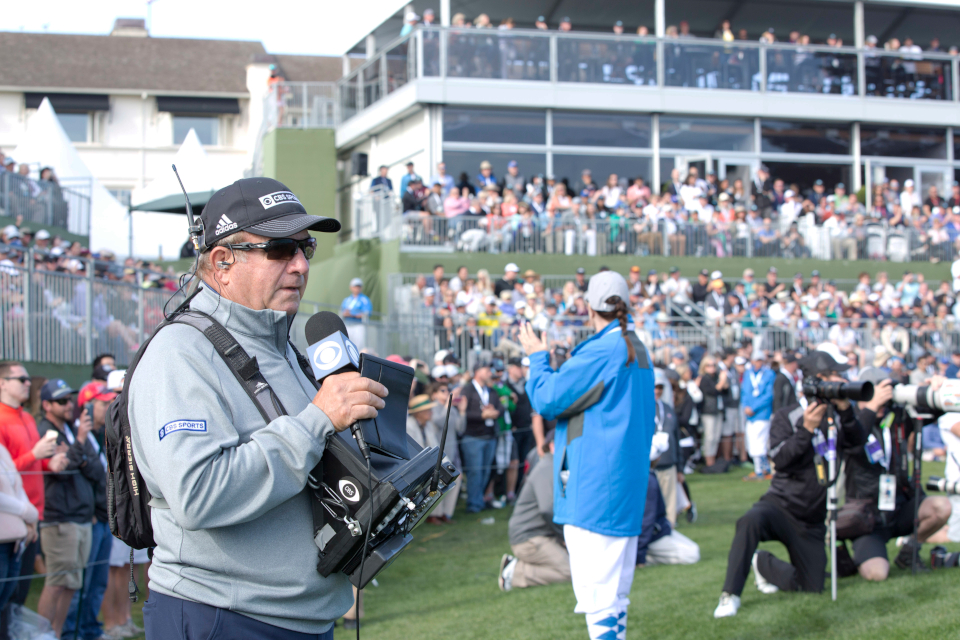Cutting-Edge Technology Drives CBS Sports’ PGA Tour Coverage
NEW YORK — When it comes to using cutting-edge broadcast technology to cover the 2018 PGA Tour, CBS Sports is going all-out to provide unique, insightful shoots of what’s happening on the course.
“Our philosophy is to use advanced technology to tell the story,” said Harold Bryant, CBS Sports’ executive producer/and senior vice president of production. “We also use it to teach the average golfer to improve their own game.” CBS Sports deploys this technology at various PGA Tour events, working out of the SSCBS mobile production unit equipped and operated by NEP.
SHOT TRACKING
It isn’t always easy for viewers to understand what’s happening on the fairways and the greens; especially when it comes to the shots being taken by golfers and how they play out.
To explain the process, CBS Sports uses Toptracer’s real-time ball tracking (“tracing”) system, which graphically portrays the ball’s trajectory, arc, and apex as it travels from golf club to ground.
[Read: Fox Sports Taps New Production Tech For U.S. Open Coverage]
CBS Sports has been using Toptracer onscreen for eight years, and has been enhancing its application for PGA coverage ever since.
The professional video industry's #1 source for news, trends and product and tech information. Sign up below.
Most recently, CBS combined Toptracer with ARL’s Virtual Eye technology and “ShotLink” shot-by-shot analytical data provided by the PGA Tour, to track the ball’s progress from an actual camera shot as well as via second-view animation showing it “flying over” the golf course. The second animated view — which is on the right side of the broadcast screen — includes ball speed, distance, and apex graphics on the screen in real-time.

“The animation looks so good, you can hardly tell the difference between it and the actual camera shot,” said Ken Aagaard, CBS Sports’ executive vice president, Innovation and New Technology.
READING THE GREEN
Every time a player approaches the cup, armchair golfers at home like to guess how they should putt the ball on the green.
CBS Sports hopes to help lessen the guesswork with “Green Reader” graphics software from Hawkeye (a Sony company). Green Reader is preloaded with a topographic 3D map of each green, and has the ability to calculate and display an onscreen “cone” showing the sweet spot for hitting the putt right. The network is currently experimenting with the technology.
“If you’re hitting it within this cone, there’s a good chance that you’re going to be in the hole or near the cup,” said Bryant. The only drawback for golfers is that they don’t have this graphic to refer to on the green. That advantage rests with CBS Sports’ viewers.
SLOWING DOWN WITH SWINGVISION
Since 2006, CBS Sports has been using high frame rate cameras to cover the shots in slow motion so that viewers can see for themselves how a golfer’s swing actually progressed. The feature — known as SwingVision — has won an Emmy.
“The enhanced color range of HDR really stands out; especially shooting in bright sunlight where SDR would provide washed-out images.” —Ken Aagaard
Typically, high-frame-rate cameras have operated at 4x real-time speed; shooting 120 frames per second vs. the standard 30fps used for broadcast.
But this wasn’t good enough for CBS Sports, which introduced a Sony 4800 16x960 fps camera at the June 2018 FedEx Cup that raised the frame rate to 16 times real-time speed, according to Aagaard. “Peter Kostis is really a whiz at describing a player’s swing, and when you see that swing using a high-frame-rate camera on SwingVision, you can see how accurate he is,” he said.
DON’T FORGET ON-COURSE TALENT
When it comes to on-course coverage from field reporters, the days of talent standing alone with their microphones are over; at least for CBS Sports and their PGA Tour coverage. When CBS Sports Reporter Amanda Balionis does live hits on the course, she has access to a 72-inch touchscreen computer mounted on a mobile golf cart known as the “SmartCart.” Like a TV studio meteorologist, Balionis can call up graphics, stats and footage on the fly.

“SmartCart makes you feel like you’re closer to the action,” said Bryant. “You can use it on site to call up golf swings and shot live to air — and then drive the cart to the next hole to keep up with the action.” CBS is the first U.S. broadcast network to use SmartCart, which it debuted in 2016.
4K/HDR, DRONES AND ATMOS
To cover golf in 4K/HDR for DirecTV’s 4K subscriber service, CBS Sports uses Sony HDC-4300 4K-capable cameras from the SSCBS mobile truck in 4K mode, giving the network valuable experience in using the technology.
Aagaard is more impressed with HDR than 4K.
“You can’t tell much of a difference between 1080p and 4K on side-by-side monitors,” he said. “But the enhanced color range of HDR really stands out; especially shooting in bright sunlight where SDR would provide washed-out images, but HDR shows a full range of shade and light levels.”
CBS Sports is also shooting pre-broadcast overhead shots using drones. “We don’t do this when there are people on the course,” Aagaard said.
As for audio, the network will begin testing Dolby’s Atmos “3D” audio capture system next month. “We were testing HDR two years ago, to stay ahead of the curve,” Aagaard said. “Same thing with Atmos; when it becomes popular with consumers, we’ll be ready.”
James Careless is an award-winning journalist who has written for TV Technology since the 1990s. He has covered HDTV from the days of the six competing HDTV formats that led to the 1993 Grand Alliance, and onwards through ATSC 3.0 and OTT. He also writes for Radio World, along with other publications in aerospace, defense, public safety, streaming media, plus the amusement park industry for something different.

